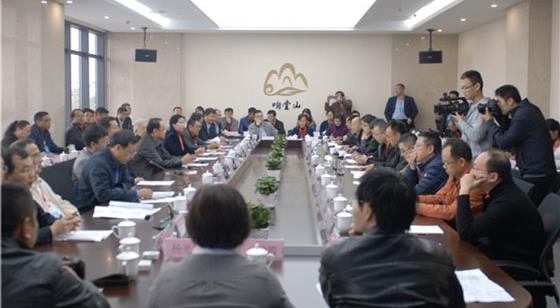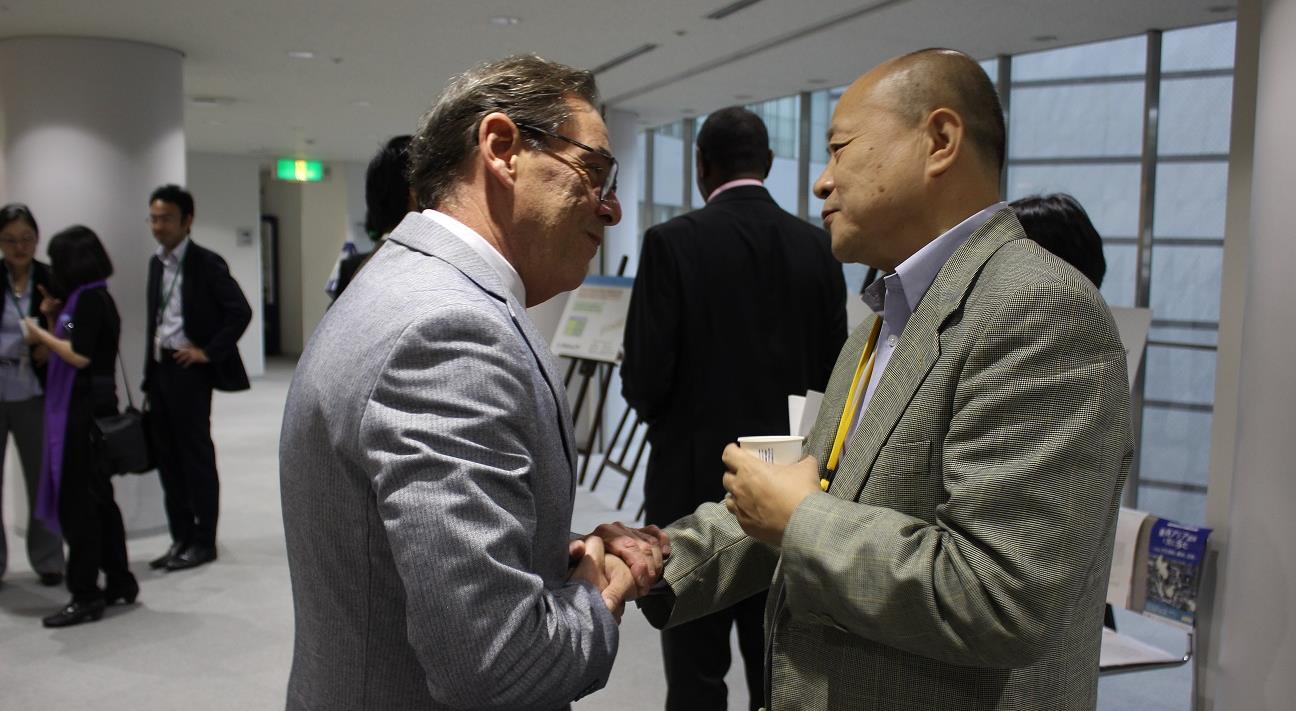-
-

- 2017-12-10 总部动态
【相约印度】中国代表参加ICOMOS亚太地区工作会议
2017年12月9日,国际古迹遗址理事会(ICOMOS)工作会议陆续召开。上午,执行委员会举行工作会(Board Meeting),讨论ICOMOS未来工作计划、本次大会筹备等事务,中国执委陆琼参加了会议。执委会会议下午2点至4点,召开了亚太地区国家委员会工作会议。会议由ICOMOS现任副主席——日本人河野俊行和澳大利亚人Peter Phillips主持。来自中国、韩国、日本、澳大利亚、新西兰、蒙古、泰国、缅甸、菲律宾、尼泊尔、印度、孟加拉国等13个国家和地区的代表纷纷上台,回顾了一年来各自开展的活动,取得的成绩,并介绍了各地文化遗产保护与利用所面临的挑战中国古迹遗址保护协会理事长宋新潮在会上发言,他表示,中国国家委员会在2017年有了四个主要变化,第一是加强了秘书处的建设;第二是增进了与高校的联系,进一步推动理论层面的探索;第三是扩大了地区上的代表性,理事遍布每个省份,同时也为香港、澳门、台湾保留了理事的席位;第四是鼓励更多青年学者参与到协会工作中,为其提供事业发展的机遇和平台。宋新潮提出,亚太地区的国家委员会之间应加强合作,以召开国家委员会主席圆桌会议等形式,探讨共同关心的遗产保护的议题。亚太地区会议现场宋新潮理事长发言中国古迹遗址保护协会副理事长姜波代表中国做工作报告,从五个方面回顾了中国一年来所开展的工作。第一,组织建设方面,选举了宋新潮为理事长的理事会。目前,共有超过108家团体会员单位,近989名个人会员,石窟寺专委会等7个专业委员会。第二,重点事务方面,主要推动了鼓浪屿成功申报世界文化遗产、“中国世界文化遗产预备清单”评估考察、“南海I号”发现30周年纪念活动等工作。第三,能力建设方面,完成了《中国世界文化遗产管理手册》(送审稿),并积极支持缅甸国家委员会的建立。第四,公众推广方面,组织了4·18国际古迹遗址日系列活动,参与了香港举办的丝绸之路展览,中山大学举办的大学生世界遗产竞赛,以及第三届中国古村镇大会等有助于遗产价值推广的活动。第五,国际合作方面,成功促成了旨在提高国内世界文化遗产地管理者工作能力的澳大利亚亚瑟港培训班,举办了水下考古培训班。由ICOMOS 西安国际保护中心举办了丝绸之路(南亚段)跨国系列申报世界文化遗产学术研讨会。姜波副理事长做工作报告石窟寺专委会年会鼓浪屿申遗成功缅甸国家委员会成立大会4·18国际古迹遗址日论坛活动大学生世界遗产竞赛丝绸之路(南亚段)跨国系列申遗学术研讨会赴澳大利亚亚瑟港培训班合影水下考古队员培训班
-
-
-

- 2017-12-05 总部动态
三年等一回:ICOMOS大会本月相约印度
本月11日至15日,国际古迹遗址理事会(International Council on Monuments and Sites,以下简称ICOMOS)第19届全球代表大会暨国际科学研讨会、年度顾问委员会会议将在印度德里召开。ICOMOS究竟是一个什么样的组织?它在国际文化遗产保护领域为什么有如此重大的影响力?让我们来看它的四大关键词。关键词一:《威尼斯宪章》1964年《威尼斯宪章》编写核心团队合影1964年5月25日至31日,在威尼斯召开了第二届历史古迹建筑师及技师国际会议。这次会议共形成了13项决议,其中的第一项决议,便是通过了《国际古迹保护与修复宪章》,即《威尼斯宪章》。它的颁布,标志着国际文化遗产保护修复进入到了新的阶段;它提出的重要原则,是五十多年来文物古迹保护修复的根本准则。此后,以《威尼斯宪章》为范本,又陆续有了《佛罗伦萨宪章》、《华盛顿宪章》、《奈良文件》、《西安宣言》等。应该说,今天国际遗产领域具有了一整套保护理念和操作体系,这一切,皆奠定于《威尼斯宪章》。2004年在匈牙利布达佩斯召开的纪念《威尼斯宪章》40周年会议的海报关键词二:专家网络在第二届历史古迹建筑师及技师国际会议上,紧随《威尼斯宪章》的第二项决议,便是成立一个致力于保护古迹遗址的国际非政府组织,即ICOMOS。如果说《威尼斯宪章》制定了一套原则,那么ICOMOS的建立,则把执行这项原则落在了实处。1965年第一届ICOMOS全体会议现场档案照半个多世纪以来,ICOMOS始终扮演着跨学科交流的专家网络的角色,致力于推广遗产保护理论、方法和科技的应用,引领全球专业领域的发展。截至2017年,它汇聚了来自153个国家的10100名个人会员,学科背景涵盖建筑、历史、考古、艺术史、地理、人类学、工程和城市规划等,并有320个团体会员,110个国家委员会,以及28个国际科学委员会。关键词三:世界文化遗产1996年出版的纪念ICOMOS成立30年的专刊封面ICOMOS最广为人知的,可能是它在世界文化遗产申报评估中的重要角色。它是唯一为世界文化遗产申报和监测提供专业评估的国际非政府组织。说通俗一点,每年世界文化遗产项目和混合遗产项目的申报环节,ICOMOS都会派遣专家对申报项目进行文本和实地考核,并给出评估意见。在很长时间内,ICOMOS的专业意见几乎等同于该项目的最后命运。不过,近年来,随着世界遗产越来越多的牵涉到了政治因素,越来越多的ICOMOS评估意见最终不被世界遗产委员会采纳。为此,ICOMOS内部也有反思的声音,认为作为世界上最大的跨国古迹遗址保护的专业组织,它不能仅仅围着世界遗产转,还要更加突出专业性和独立色彩。关键词四:远离政治和每年召开的世界遗产委员会会议浓重的政府色彩不同,ICOMOS始终坚守自己的非政府性和独立性。本次会议前,由于参会人员中包括一名叙利亚建筑师,本计划向会议提供资助的美国盖蒂基金会基于政治考量,要求ICOMOS拒绝该建筑师参会,否则就撤回此前承诺的8万欧元捐助。ICOMOS恪守其“非政府组织”的定位,断然拒绝了盖蒂基金会的要求,并通过其他渠道筹款,以保证会议的正常开幕。ICOMOS真的可以远离政治风云的侵扰,保持专业团体的名节吗?1987年在美国华盛顿特区召开的第八届全体会议大合影实际上,成立50多年来,ICOMOS始终在专业性和政治性中间艰难的寻找着平衡。作为世界遗产委员会的三大专业咨询机构之一(另外还包括侧重文化遗产保护和修复研究及培训的ICCROM,以及为自然遗产项目提供服务的IUCN),它自成立伊始,便接受联合国教科文组织在资金和组织层面的大力协助,如今更是成为了国与国之间的文化较量的国际平台。想要摆脱政治二字,谈何容易。本届大会看点ICOMOS的全球代表大会和科学研讨会每三年召开一次,是全世界古迹遗址保护领域的专业人员的大聚会。本次大会有什么看点?2011年在法国巴黎召开的第17届全体会议现场选举三年等一回,必然是要有大动作,这次ICOMOS大会最重要的议题便是更换领导团队,将选举出新的主席、秘书长和司库(俗称“三巨头”),选举5位副主席,以及12位执委。选举日期为12月14日。这20个人将组成未来三年的ICOMOS领导集体。目前,根据大会网站信息,“三巨头”的候选人分别只有一位,分别是日本人河野俊行(现任副主席,竞选主席)、澳大利亚人彼得·菲利普(现任副主席,竞选秘书长)、南非人劳拉·罗宾森(现任司库,竞选连任司库)。副主席共有7名候选人竞争5个名额,执委则由16名候选人竞争12个名额。2014年在意大利佛罗伦萨召开的第18届全体会议宣传海报学术三年一次的科学研讨会,将云集全球超过1500名文化遗产领域的学者,进行理论探讨、案例分享,并就当下的热点议题切磋讨论。本届国际科学研讨会的主题为“遗产与民主”。同时,研讨会还分为三个分议题:1:通过多元遗产管理群体的参与使遗产融入可持续城市发展Integrating Heritage and Sustainable Urban Development by engaging diverse Communities for Heritage Management2:文化遗产在构建和平与和解中的作用The role of Cultural Heritage in building Peace and Reconciliation3:数字赋权时代的文化遗产保护与阐释Protecting and Interpreting Cultural Heritage in the age of Digital Empowerment另外,ICOMOS和IUCN近年来致力于打破文化-自然的区隔,开展了“自然-文化之旅”(Nature-Culture Journey)项目,本次会议上,关于此类议题也将专题研讨。专项决议按照往届惯例,科学研讨会的最后将形成并发布一个共同的文件,本次大会的文件名为《德里宣言》。2014年在意大利佛罗伦萨召开的第18届全体会议现场合影宣言草案将在科学研讨会上由世界各地的专家进行审议并修改,并在大会结束时正式发布。宣言内容将围绕本次大会的主题——“遗产与民主”展开,并纳入三个分议题和“自然-文化之旅”的讨论成果。尽管宣言文本为何尚不知晓,但可以预计的是,《德里宣言》将延续近年来国际遗产领域的总体思潮,更加强调人和社区在遗产保护中的重要性,更加突出遗产保护中“以人为本”的精神。在《德里宣言》之外,本次大会还将发布四个专业性文件,即《乡村景观遗产准则》、《历史城市公园文件》《考古遗址管理准则》和《木建筑遗产保护准则》。这四份文件已经在去年的工作会议上初步讨论,并在全球征求书面意见,如无意外,本届大会上将正式通过。特别提示:中国古迹遗址保护协会(ICOMOS China)将派出专家团队参加本次会议。我们将与“清源文化遗产”、“世界遗产之声”一起,在新德里为您带来第一手的消息,并及时编译会议成果,敬请关注。
-
-
- 2017-06-19 总部动态
《国际古迹遗址理事会关于文化遗产灾后复原与重建的导则》现已上线
This document was prepared in response to the request for guidance on reconstruction expressed in the World Heritage Committee decision (Decision 40 COM7) at its 39th session in Bonn, Germany.It was largely developed through the deliberations of an international workshop on reconstruction convened at ICOMOS Headquarters in Paris in September 2016 and sponsored by Kyushu University, Japan.The workshop was attended by a geographically and professionally diverse group of twenty participants. The feedback and comments from numerous ICOMOS National Committees and from our colleagues at UNESCO, some of whom participated in the workshop, were integrated into the document.It should be regarded as the 2017 version of a working document that will be tested, revised and refined through experience and reflection.英文版下载链接:ICOMOS GUIDANCE on POST TRAUMA RECOVERY AND RECONSTRUCTION for WORLD HERITAGE CULTURAL PROPERTIES 更多语种版本下载链接:http://openarchive.icomos.org/1763/
-
-
-

- 2016-12-19 总部动态
ICOMOS极地遗产专委会国际会议将于明年9月在新西兰召开
ICOMOS International Polar Heritage Committee (IPHC) Conference Christchurch New Zealand, 28-29 September 2017 The IPHC 2017 Conference theme is Polar heritage and the ships behind it: management and protection.Getting to and from polar regions has been a constant issue for all polar expeditions, and the ships that made this happen are a key component of polar heritage.The IPHC 2017 conference will explore the many aspects that arise in the management and protection of these vessels including: Historic shipwrecks in polar regions both on land or underwater Polar ships that survive as museum displays Ownership of polar wrecks and remnants Relocation of polar wrecks and remnants Use of modern polar ships to access polar heritage sites Indigenous use of ship-wreck materials, indigenous input relating to wreck history, and indigenous/non-indigenous interactions related to polar ships and crews Royal Canadian Mounted Police ship patrols and their influence on indigenous groups in arctic Canada World War II ships, and the history of polar convoys Law issues and the protection of underwater heritageThe IPHC 2017 Conference Organising Committee invites submissions of papers that address this theme. Please submit a 300-word abstract and title by 28 February 2017, together with the name(s) of the author and email address to Karen Clarke by email.For more information, please visit: http://www.polarheritage.com/polarheritage/IPHCConference2017/
-
-
- 2016-11-25 总部动态
ICOMOS保护与修复理论专业委员会将于明年3月在意大利召开国际会议
12th Conference of the ICOMOS International Scientific Committee on Theory and Philosophy of Conservation & RestorationCall for abstractsInvited Committee: ICOMOS International Scientific Committees on Interpretation & PresentationTheme: Place of Memory – Protection, Conservation, InterpretationPlace and Date: Florence, Italy, 8-10 March 2017The term place of memory (lieu de memoire) has been used in heritage protection with increased frequency. A ‘place of memory’ is a property or site vested with historical significance due to the nature of the historic events that occurred there. What differentiates places of memory from other categories of heritage is the relation between the material and non-material components of the site. In ‘places of memory’, the non-material component is offar greater importance than the material one.In historical studies, the term place of memory conveys several meanings, including metaphorical ones. In heritage protection, however, the meaning of this phrase narrows down to such sites as battlefields, places of birth or death of important persons, killing and captivity sites, disaster areas, and other sites of similar historical significance. These sites are characterised by the humble nature of material components—or even absence of any material components at all— compared to the immaterial value/significance attributed to these sites.As the term place of memory is still new in heritage protection and conservation, it needs to be developed in both its theoretical and practical aspects. It is therefore necessary to coin fundamental terms for the sites in question, formulate principles of conservation-related actions to be taken in these places, and popularise examples of protecting and interpreting places of memory.Forms of conservation actions and the rules governing them should depend on the values of the site, its material features of an asset, its non-material values, and the relationship between these components. These aspects are a part of the conservation theory.Deadline for abstracts – 20 December 2016For more information, please visit:http://australia.icomos.org/wp-content/uploads/2017.-03-Florence-Place-of-Memory-call-for-abstracts.pdf
-
-
- 2016-10-21 总部动态
国际古迹遗址理事会与九州大学联合主办的“关于被破坏的文化遗产重建问题”研讨会将于明年3月在巴黎召开
ICOMOS University Forum Workshop on Authenticity and Reconstructions 13 – 15 March 2017ICOMOS and Kyushu University, Japan will jointly convene an international workshop in 2017. The workshop is intended as an opportunity to engage in open and constructive discussion on the subject of the reconstruction of destroyed/damaged cultural heritage.Under the title “A contemporary provocation: reconstructions as tools of future-making”, the venture is a pilot initiative of the ICOMOS University Forum, and will be hosted by ICOMOS in Paris from 13-15 March 2017.Three themes are proposed. Theme 1: From Nara to Nara+20: where is authenticity now? Authenticity has long been the normative framework for discussions about reconstruction. Thirty years after the Venice Charter, the Nara Document recognized the cultural dimension of development. Since then the interrelationship between heritage and society obtained practical significance and intensified in many ways. Today, authenticity is back on the agenda and turns out to be a complex topic of different definitions and perspectives brought to bear on a variety of contemporary reconstructions of the past. This is the context where we should approach authenticity today to ask ourselves “where are we now”? Theme 2: Creating heritage-making futures? It has long been held that the legacy of the past needs to be conserved for the benefit of future generations, as well as for our own. In conserving what we received we have created “heritage”. In this theme we ask about the positive contributions that such heritage can make to the lives of future generations, in the light of the impacts of historical, cultural and natural changes and transformations. How will what we now accept as heritage improve specific futures? Is there a role for reconstructions?Theme 3: Conservation as management Conservation has long been considered as the management of change. A primary change has been in understanding the scope of the legacy. In parallel, the range of stakeholders has extended beyond the traditional conservation disciplines and authorities to encompass disparate social groups and communities, participants in identifying and valorising aspects of the legacy, including its potential reconstructions. We ask what consequences for reconstruction flow from this process of change, from the shift in the social roles, powers and capacities that are brought to bear, including the implications for understanding, resource allocation and knowledge and cultural development.The Workshop ConceptThe Workshop is intended to be an intensive, exploratory experience in which the participants engage in open discussion in a multi-disciplinary environment. Numbers will be small (30-35) in order to encourage the maximum engagement with the perspectives of participants. The language of the Workshop will be English.The Workshop will be constructed as follows:1. Participants will be confirmed on the basis of short abstracts (500 -1000 words), received by the Working Group by 18 November 2016. Abstracts may be submitted either in English or in French. Decisions of acceptance will be made by 10 November 2016.2. The selected abstracts will be circulated to all participants in advance of the workshop.3. Following brief introductory context-setting statements, participants will be assigned to a small group devoted to one of the three themes outlined above. While, in assigning participants to each group, consideration will be given to the choice of theme by the participants, the overriding concern of the organisers will be to ensure that groups are as balanced as possible.4. Groups will be asked to prepare a summary of their discussions for presentation to the workshop at a plenary session.5. Following the workshop, these summaries will be circulated to all participants.6. At this stage, participants will be asked to prepare full papers in English (6000 words) with a view to publication. These papers will generally develop the theme of the participants’ original abstract. However, they must also explicitly reflect on and take into account the discussions that have taken place during the workshop. This requirement is a precondition for publication.7. The papers will be peer-reviewed by the Working Group and considered for academic publication in a printed volume. All peer-approved papers will be published open-access online with permanent availability.Abstracts should bear a title and the name and academic affiliation of the author, and be submitted as a .doc or .docx file to: secretariat@icomos.org with the subject line “ Your last name/ ICOMOS University Forum Workshop on Authenticity and Reconstructions”.Further particulars concerning the arrangements for the workshop will be sent to the authors of accepted Abstracts early in 2017.
-
-
-

- 2016-07-04 总部动态
ICOMOS2015年度报告现已发布,欢迎下载
For more information, please visit: http://www.icomos.org/en/about-icomos/mission-and-vision/icomos-mission/annual-report/7651-icomos-annual-report-2015-now-available
-
-
- 2016-05-25 总部动态
2016年度ICOMOS顾委会暨科学研讨会将于10月在伊斯坦布尔召开
Call for Papers2016 Advisory Committee Symposium20 October 2016, Istanbul, TurkeyPOST-DISASTER RECONSTRUCTIONThis year’s symposium addresses the destruction of cultural heritage through natural disasters and armed conflict. The destruction of places of symbolic value has long been a device of war, with societies and civilizations overturned and their artefacts dissipated and destroyed.We are currently witnessing the the deliberate destruction of cultural heritage through armed conflict in many parts of the world.Increasingly we are also witnessing the destruction of heritage places through severe natural disasters that are expected to increase as climate change generates extreme weather events.The theme of POST-DISASTER RECONSTRUCTION is extremely relevant as societies impacted by natural disasters, terrorism and war seek to rebuild themselves and request external assistance. This brings with it many challenges and risks, as well as possible opportunities.ABSTRACT SUBMISSION GUIDELINESAbstracts for papers and posters are expected to be short documents which contain a clear statement of the topic, the research question and examples of clear case studies and good practices.The content of abstracts for submission should include:- Clear objectives- Methodology- Summary of key findings and recommendations- A short outline of historical and contemporary case studies relating to your topic.Abstracts should be submitted in English or French. The text must not exceed 500 words and must be typed according to the template below.Abstracts should be sent by email in both Word and PDF formats to scsymposiumicomos2016@gmail.com by 3 June 2016. Please include the words ‘2016 Scientific Council Symposium’ in the subject line of your email.For more information, please visit: http://www.icomosadcom2016.com/scientific-symposium/
-
-
-
- 2015-11-02 总部动态
2015年ICOMOS顾问委员会、年度大会和科学研讨会闭幕
2015年ICOMOS顾问委员会、年度大会和科学研讨会于2015年10月26-29日在日本福冈召开。国家文物局副局长、中国古迹遗址保护协会理事长童明康率团参会。会议期间,童明康理事长与各国参会代表进行了广泛交流,特别就支持ICOMOS开展科学研究、2016年在我国召开ICOMOS保护理论和哲学科学委员会年度会议和科学研讨会、参与2016年IUCN年度大会中“文化与自然旅程”论坛、与澳大利亚亚瑟港管理局开展世界遗产地管理经验交流、推动协会科学委员会建设、加强与对口的国际科学委员会交流,以及在国际ICOMOS网站上刊登《中国文物古迹保护准则》(2015年修订)等事宜,与ICOMOS主席、财务总监、秘书长、秘书处及相关代表进行了洽谈,取得了丰硕成果。国际古迹遗址理事会执委、协会双秘书长陆琼参加了ICOMOS执委会和其他会议,并代表协会在地区小组会议上做了2014年度工作报告。协会在过去一年工作的数量和质量得到了亚太地区代表的高度评价。协会新出版的《中国文物古迹保护准则》(2015年修订)和《红河哈尼梯田文化景观可持续发展国际研讨会论文集》泛发给了ICOMOS执委会成员以及国家委员会和国际科学委员会主席,宣传了协会的工作。ICOMOS顾问委员会选举出了新一届班子:20世纪遗产国际科学委员会主席Sheridan Burke当选顾问委员会主席;爱尔兰国家委员会主席Deirdre McDermott当选为副主席;非物质遗产科学委员会主席Susan McIntyre-Tamwoy,法务、管理和经济国际科学委员会秘书长James Reap,韩国国家委员会主席Hea Un Rii和哥斯达黎加国家委员会主席Ofelia Sanou Alfaro当选为顾问委员会官员。年度大会审议通过了2014年度财务报告和2015年度预算。以“遗产地身份面临的危险 – 传统和集体记忆的丧失”为主题的科学研讨会从集体记忆的延续、文化景观的延续和变迁,以及非物质遗产、认同性和变化等方面对如何保护传统和集体记忆进行了研讨。童明康理事长与ICOMOS副主席飞利浦交谈童明康理事长与ICOMOS主席阿罗兹商议资助ICOMOS研究事项童明康理事长与澳大利亚ICOMOS前主席哈里顿探讨中澳世界文化遗产管理经验交流事宜童明康理事长与波兰ICOMOS邦高斯拉夫讨论2016年在我国举办ICOMOS理论科学委员会年会事宜秘书处2015年10月30日
-
搜索SEARCH
CHINESE NATIONAL COMMITTEE FOR THE INTERNATIONAL
COUNCIL ON MONUMENTS AND SITES
COUNCIL ON MONUMENTS AND SITES


